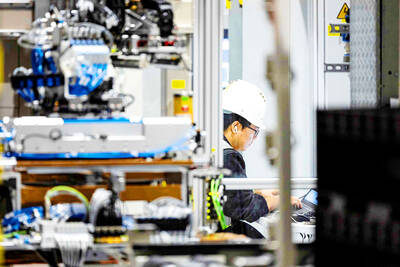The Financial Supervisory Commission is taking steps to reduce the burden of life insurers’ foreign-exchange hedging costs, which have risen because of the wide gap between Taiwan and US interest rates.
Local insurers would be allowed to apply to increase foreign exchange reserve (forex) volatility reserves from other reserve pools, Insurance Bureau Deputy Director-General Tsai Huo-yen (蔡火炎) said at a briefing yesterday in Taipei.
The changes would effectively boost insurers’ forex hedging reserves to as much as NT$960 billion (US$30.1 billion) from the current level of NT$300 billion, Tsai said. This would reduce their need for hedging tools like currency swaps and non-deliverable forwards, lowering hedging costs.

Photo: CNA
New rules would also double the so-called extra deposit and offset rate for the forex gains and losses of insurers’ unhedged assets and liabilities to 100 percent.
The New Taiwan dollar has declined about 4 percent this year against the greenback, with the local benchmark interest rate of 2 percent less than half of the 5.25 percent to 5.5 percent in the US.
The industry spent more than NT$360 billion hedging against foreign exchange fluctuations last year, commission data showed.
Taiwan first introduced the reserves mechanism in 2012, allowing insurers to deposit part of their forex gains to the pool and tap the funds to hedge against losses, in a way to smooth out their profits. It revised the rules in 2019 and again last year to increase the flexibility of forex risk management.
The total pool of reserves across life insurers increased 66 percent to NT$231 billion from the start of this year through last month, official data showed. While life insurers reaped forex gains of NT$923.7 billion so far this year thanks to a weaker NT dollar, hedging tool losses and costs totaled NT$894.2 billion.

CHIP RACE: Three years of overbroad export controls drove foreign competitors to pursue their own AI chips, and ‘cost US taxpayers billions of dollars,’ Nvidia said China has figured out the US strategy for allowing it to buy Nvidia Corp’s H200s and is rejecting the artificial intelligence (AI) chip in favor of domestically developed semiconductors, White House AI adviser David Sacks said, citing news reports. US President Donald Trump on Monday said that he would allow shipments of Nvidia’s H200 chips to China, part of an administration effort backed by Sacks to challenge Chinese tech champions such as Huawei Technologies Co (華為) by bringing US competition to their home market. On Friday, Sacks signaled that he was uncertain about whether that approach would work. “They’re rejecting our chips,” Sacks

It is challenging to build infrastructure in much of Europe. Constrained budgets and polarized politics tend to undermine long-term projects, forcing officials to react to emergencies rather than plan for the future. Not in Austria. Today, the country is to officially open its Koralmbahn tunnel, the 5.9 billion euro (US$6.9 billion) centerpiece of a groundbreaking new railway that will eventually run from Poland’s Baltic coast to the Adriatic Sea, transforming travel within Austria and positioning the Alpine nation at the forefront of logistics in Europe. “It is Austria’s biggest socio-economic experiment in over a century,” said Eric Kirschner, an economist at Graz-based Joanneum

BUBBLE? Only a handful of companies are seeing rapid revenue growth and higher valuations, and it is not enough to call the AI trend a transformation, an analyst said Artificial intelligence (AI) is entering a more challenging phase next year as companies move beyond experimentation and begin demanding clear financial returns from a technology that has delivered big gains to only a small group of early adopters, PricewaterhouseCoopers (PwC) Taiwan said yesterday. Most organizations have been able to justify AI investments through cost recovery or modest efficiency gains, but few have achieved meaningful revenue growth or long-term competitive advantage, the consultancy said in its 2026 AI Business Predictions report. This growing performance gap is forcing executives to reconsider how AI is deployed across their organizations, it said. “Many companies

France is developing domestic production of electric vehicle (EV) batteries with an eye on industrial independence, but Asian experts are proving key in launching operations. In the Verkor factory outside the northern city of Dunkirk, which was inaugurated on Thursday, foreign specialists, notably from South Korea and Malaysia, are training the local staff. Verkor is the third battery gigafactory to open in northern France in a region that has become known as “Battery Valley.” At the Automotive Energy Supply Corp (AESC) factory near the city of Douai, where production has been under way for several months, Chinese engineers and technicians supervise French recruits. “They